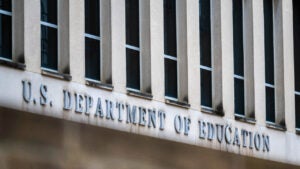How the Fed rate changes impact student loan interest rates




Key takeaways
- Interest rates on federal student loans are set on July 1 each year for loans disbursed from July 1 to June 30 of the following year.
- Borrowers with existing federal student loans will not see any changes when the Fed lowers interest rates.
- Private student loan rates — especially variable ones — are more directly influenced by Fed rate decisions.
- The Federal Reserve lowered rates for the third time in a row during the December 2025 meeting.
The Federal Reserve plays a major role in shaping borrowing costs, but how exactly does that impact your student loans? The answer depends on the type of loan you have. While federal student loans come with fixed rates that don’t change mid-loan, private student loans — especially variable ones — often rise or fall in response to Fed moves. Even prospective federal loan borrowers should pay attention, as new loan rates reset every July based on market trends.
At the December 2025 Federal Reserve meeting, the Fed lowered its benchmark interest rate to 3.5-3.75%. As that’s the Fed’s third rate cut of the year, this should eventually translate to lower rates for private student loans.
How do Fed rate changes affect student loan interest?
While the federal funds rate isn’t the exact interest rate you’re charged for taking out credit, it impacts lenders’ borrowing costs, and these costs get passed onto consumers. In other words, if the Fed raises interest rates, the average interest rate on loans will also increase over time. Likewise, if the Fed cuts interest rates, lenders are likelier to gradually lower their interest rates.
Here’s a simple breakdown of how the Fed’s decisions affect loans with variable rates but not ones with fixed rates:
- Fixed rates: Stays the same for the life of your loan. Existing federal loans fall under this category. Private loans also offer fixed rates.
- Variable rates: Fluctuate over time, typically tied to indexes like the prime rate, the benchmark rate used by banks to determine their lending rates, or other market benchmarks influenced by the Fed.
How the Fed’s decisions affect federal student loans
Federal student loan rates are set by Congress each year. These rates apply to loans disbursed between July 1 of the current year until June 30 of the following year and remain fixed for the life of the loan. Borrowers with existing federal loans won’t see rate changes based on the Federal Reserve’s decisions, but new borrowers could face higher rates if market conditions push the Fed to change its rates.
2025-2026 Federal student loan rates
| Loan type | Borrower type | Fixed interest rate |
|---|---|---|
| Direct subsidized/unsubsidized loans | Undergraduate | 6.39% |
| Direct unsubsidized loans | Graduate or professional | 7.94% |
| Direct PLUS loans | Parents and graduate or professional students | 8.94% |
| Source: Federal Student Aid |
Proposals to overhaul the federal student loan system — including eliminating income-contingent repayment programs — have been proposed in recent months. Stay informed on policy shifts that could affect future borrowing options.
How the Fed’s decisions affect private student loans
Private student loan lenders set student loan rates based on lender costs, borrower qualifications like credit score and market benchmarks — such as the London Interbank Offered Rate (LIBOR).
- Variable-rate loans: Most sensitive to Fed decisions. Rates may adjust periodically, meaning payments can increase or decrease based on market trends.
- Fixed-rate loans: Rates stay locked for the life of the loan, offering predictability but generally starting higher than variable rates.
Bankrate’s student loans expert Lauren Nowacki, advises students to shop around for the best rates and if the Fed raises rates, borrowers can still take action to get the best rates.
While interest rates move with the Fed’s actions, they do still vary by lender. Even when rates increase, there are still actions you can take to ensure a lower rate, including building your credit or using a cosigner with a strong credit profile.— Lauren Nowacki, Senior Writer
How to respond to Fed rate changes
In an environment with fluctuating interest rates, your next best steps can vary from doing nothing to refinancing your loans. Here are some tips that can guide you based on the type of student loans you have.
Federal student loans
- Existing borrowers are unaffected by Fed decisions.
- New loans reset annually, so monitor the Fed’s decisions — are the rates in an upward or downward trend?
- Federal loans include protections like income-driven repayment and forgiveness options — benefits you miss out on if refinancing into private loans.
Fixed-rate private student loans
- Fed changes don’t impact current fixed-rate loans.
- If rates drop significantly and your credit has improved, refinancing could lower your payments.
Variable-rate private student loans
- Expect your rate to adjust based on market conditions influenced by the Fed.
- If your payments increase, shop around for the best refinance rate options. You may lock in a lower, fixed rate if you qualify.
When to refinance your student loans
Student loans expert Nowacki says now may be a good time to refinance your private student loans, even if the Fed is not moving rates.
If current interest rates are lower than what you have on your loans, you can save thousands of dollars on the total interest you’ll pay by refinancing at a lower rate. You may even be able to lower your monthly payment or pay your loan off faster.— Lauren Nowacki, Senior Writer
Are you wondering if you should refinance your student loans? Do it only when these situations apply:
- You have a solid credit score: Since you’re taking out a loan with a private lender, your credit score and credit history will determine your new interest rate. If you don’t have an excellent or even good credit score, your interest rate will be higher than that of someone with a better score.
- You have private student loans: Federal student loans have several protections, like deferment or forbearance and income-driven repayment plans. Those go away when you refinance. If you have private student loans already, you don’t stand to lose these benefits.
- You’ll get a lower interest rate: If you have a high interest rate — whether it’s fixed or variable — a good chunk of your monthly payments might be going toward interest instead of your principal balance. If you can secure a lower interest rate, you’ll get a lower monthly payment. If you’re struggling to make payments now, this might be your biggest determination for refinancing.
- You feel confident with your job security: Private loans generally don’t offer deferment and forbearance for those experiencing financial hardship, so be wary of refinancing any federal loans if there’s a risk you could lose your job.
Be cautious if you have federal loans
- Refinancing federal loans with a private lender means losing access to federal benefits, including income-driven repayment plans, deferment, forbearance and potential loan forgiveness programs.
- Consider refinancing only if you’re confident you won’t need these protections.
Bottom line
The Fed’s decisions won’t necessarily impact your student loans. That said, if you have a variable student loan rate, or if you’re hoping to take out a new student loan, it’s worth keeping an eye on how the federal funds rate changes. Timing your student loan correctly could help you save money on interest over time.
Why we ask for feedback Your feedback helps us improve our content and services. It takes less than a minute to complete.
Your responses are anonymous and will only be used for improving our website.
You may also like

Pros and cons of consolidating student loans

Guide to student loan interest rates


